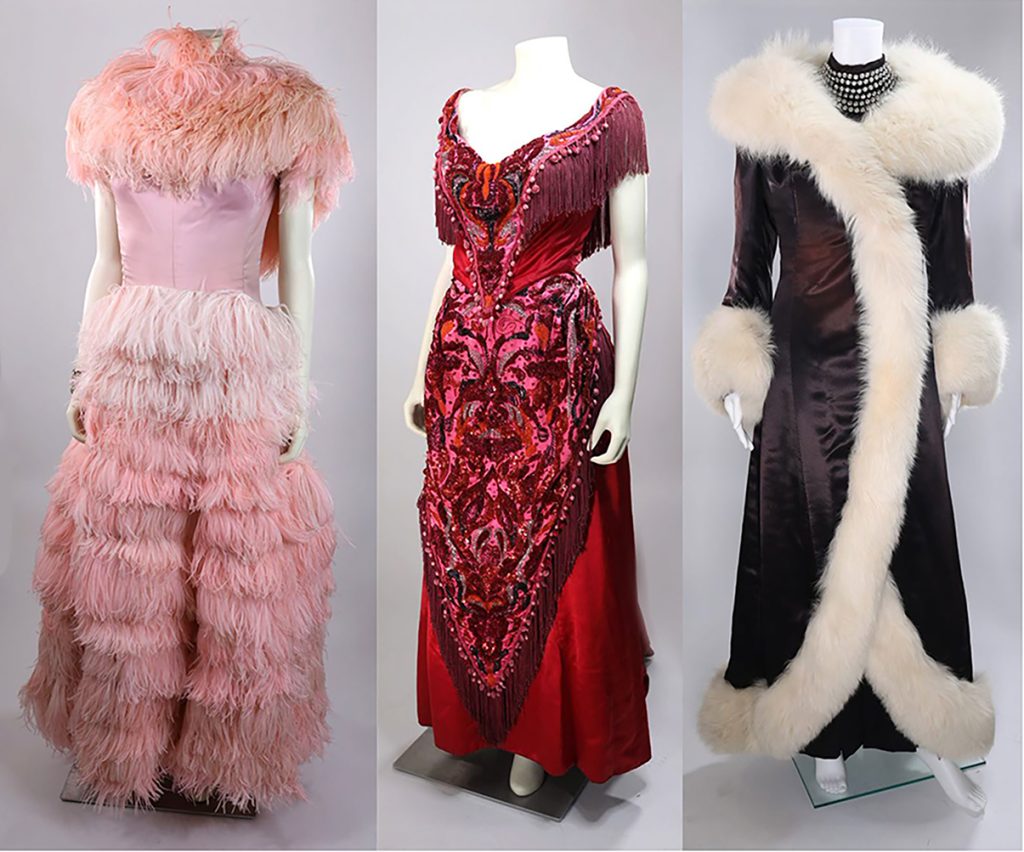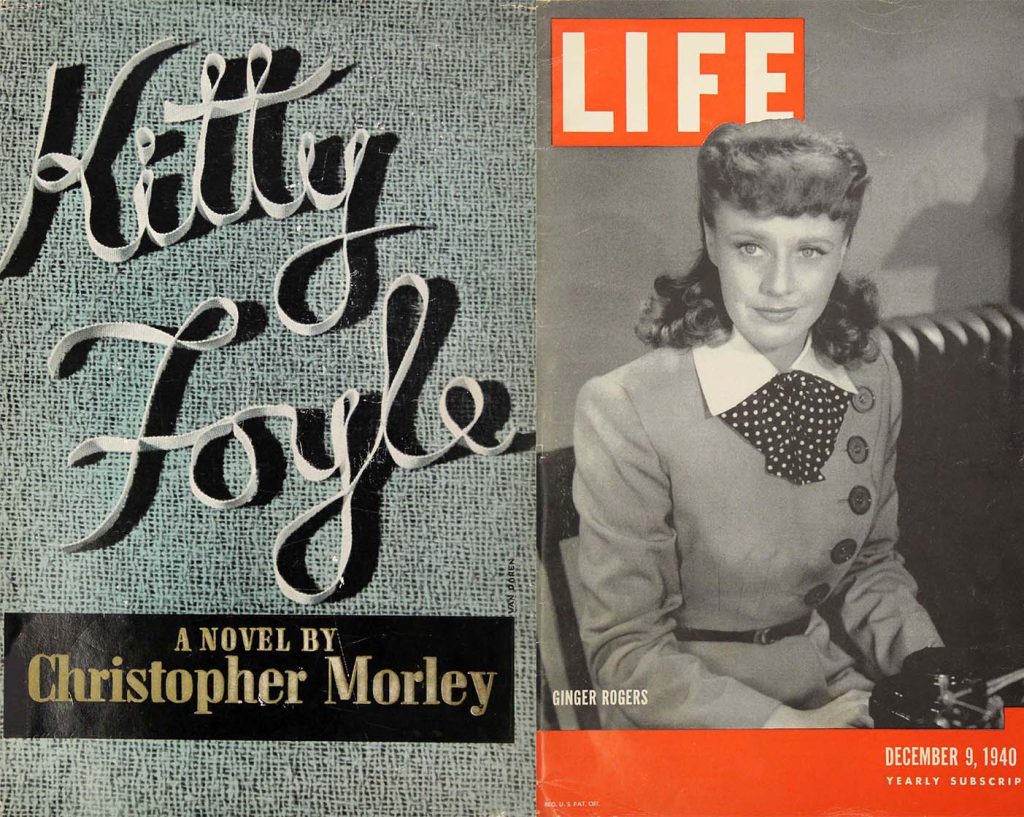Ginger Rogers Collection

GINGER ROGERS: LEGENDARY, AWARD-WINNING PERFORMER
A growing collection of costumes worn by Ginger Rogers (1911-1995) and a variety of related archival resources have been gifted to the Missouri Historic Costume and Textile Collection (MHCTC) within the Department of Textile and Apparel Management (TAM) in the College of Arts and Science. Several of these costumes and archives were previously maintained by Roberta Olden, Rogers’ personal assistant from 1977 to 1995. As the steward of much of Rogers’ costume and clothing, Olden selected the MHCTC as the permanent home for garments curated from Rogers’ nightclub revue and stage career. Olden was referred to the MHCTC by Marge Padgitt, founder of the Owens-Rogers House Museum, Rogers’ childhood home in Independence, Missouri. Padgitt also gifted three Rogers garments, a nightgown set designed by Rogers, two pairs of gloves, and a variety of magazines and other media from her own curated collection beginning in 2021. The majority of garments and archives in the Ginger Rogers Collection were worn by Rogers during her later career of the 1960s through the 1970s.
The importance of fashion to Ginger Rogers’s success as a performer cannot be denied. Her Hollywood film costumes by legendary studio designers such as Bernard Newman, Edith Head and Jean Louis became legendary themselves. Many of them, and the dance numbers in which they appeared, later influenced a variety of Rogers’ costume and performance choices in her solo career, particularly those of her late 1970s nightclub revue The Ginger Rogers Show. In fact, Rogers herself quoted in her autobiography, “I can never emphasize enough how important clothing was to me.”
For Rogers, costume was critical: critical to making performance and critical to spectatorship. Rogers recognized from a young age the role of clothing as part of a complex performative dynamic: it is in the context of the performing body that ideas are experienced, communicated and understood. It is the viewers’ understanding of the clothed and communicating body and their own memories and experiences that enable them to engage and connect with the ideas and narratives revealed. Award-winning Hollywood designer Edith Head described Rogers as “such a definite personality that, although she can convincingly assume the role of child or of sophisticate, the strong personality is always Ginger. No matter how you dress her, the clothes get the stamp of her individuality. She doesn’t really put on a costume as an actress would, but as a girl getting ready for a high school prom, wanting her dress to be prettiest. It’s a game of make believe… Ginger never will grow old; she has some element of clear spring in her chemistry. With one of the best figures in Hollywood, she can and does wear the beaded ball gown, but she loves the gingham dress.”

An icon of American dance and film, Ginger Rogers (1911-1995) was born in Independence, Missouri as Virginia Katherine McMath. From her place of birth at 100 Moore Street, Rogers moved to her grandparents’ home on Bellafontain Street in Kansas City, Missouri, during which time she made her first appearance before a movie camera in a local optician’s commercial. At age five, Ginger Rogers and her mother moved from Kansas City to New York where Rogers had her first professional stage and costume experiences. From New York, Rogers moved to Texas in 1922 with her mother and stepfather John Rogers. In 1925, Rogers became the Texas State Charleston Champion and was awarded the opportunity to perform in a touring vaudeville act titled “Ginger and the Redheads. At the age of 17, Rogers returned to New York with her mother where Rogers earned several jobs on the radio and landed her Broadway theater debut in the musical Top Speed (1929). At age 19, Rogers starred in George and Ira Gershwin’s new Broadway musical Girl Crazy (1929), an appearance which made her an overnight star. The following year, Rogers made her first film appearances in Young Man in Manhattan, Queen High, The Sap from Syracuse, Night in a Dormitory, and Follow the Leader.
In 1933, at the age of 22, Rogers began her legendary partnership with fellow dancer Fred Astaire in the film Flying Down to Rio. Among the most famous duos in Hollywood history, Rogers and Astaire are credited with revolutionizing the musical genre with popular films such as The Gay Divorcee (1934), Top Hat (1935) and Swing Time (1936). Her last two films with Astaire included The Story of Vernon and Irene Castle (1939) and The Barkleys of Broadway (1949). In the late 1930s, Rogers branched out into dramatic comedy films. In 1941, Rogers won an Academy Award for Best Actress in a Leading Role for her dramatic performance in the 1940 film Kitty Foyle. The New York Times identified Rogers as the highest paid woman in Hollywood in 1941. Rogers’ last motion picture was Harlow in 1965.
After a twenty-year absence from the stage, Rogers appeared in Love and Let Love in 1951 in New York. From 1965 to 1967, Rogers played the lead role in Broadway’s long-time smash hit Hello, Dolly! The national tour of the show stopped in over sixteen cities, with the final curtain call in Boston, Massachusetts, in 1968. From 1969 to 1970, Rogers appeared in the London theatrical production Mame. In the summer of 1975, Rogers made the decision that “instead of doing somebody else’s material, dialogue, and songs, [she] should do those musical numbers associated with [her] own career.” The Ginger Rogers Show was born that same year for which she asked award-winning Hollywood designer Jean Louis to design costumes. The nightclub revue toured the U.S. and worldwide to Canada, Australia, Mexico, Argentina, and England through 1979. In 1980, Rogers performed with the legendary Rockettes in Rockette Spectacular at Radio City Music Hall. Her filmography from 1940 to 1984 includes 31 film and radio performances, 19 stage appearances (her last in 1984), innumerable magazine features, and a jazz album. Rogers starred in a variety of comedies and dramas with such leading men as Cary Grant, Henry Fonda, and Ronald Reagan, appearing on television with Perry Como, Bob Hope, Pat Boone, Steve Allen, Dean Martin, Lucille Ball, June Allyson, and more. Her autobiography titled Ginger Rogers: My Story was published in 1991. Ginger Rogers maintained one of the longest successful careers in Hollywood spanning over six decades from the 1920s to 1984.
Click the links below to explore costume and archives of this legendary, pioneering, and ambitious Missouri native in MHCTC collections. Additional related exhibitions and collaborative scholarship will be coming soon!

